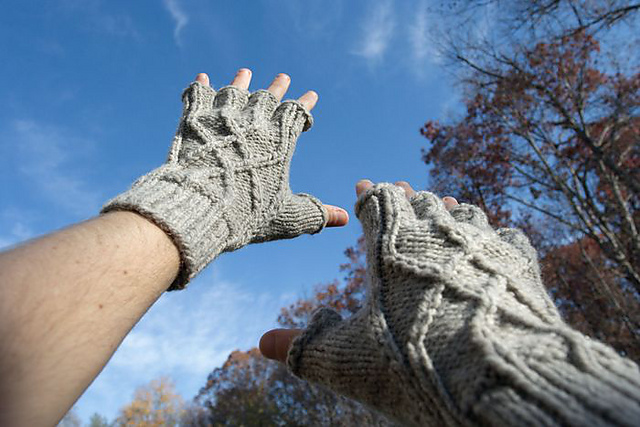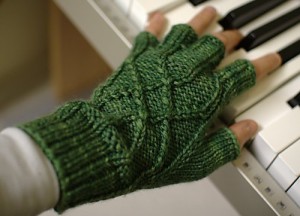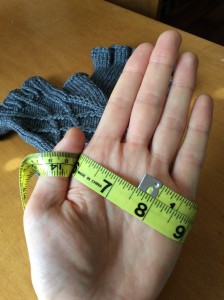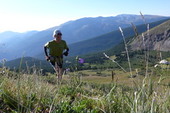Download the pattern: Quadruple Cross Mitts
I made the first pair of these mitts in 2009. I came up with a rough sketch, then took notes on the design as I went along. I intended to write up the pattern immediately afterward. A year later, when I still hadn’t written up the pattern, I decided I needed to make another pair to make sure that my notes were correct. I did that, and again, failed to formally write up the pattern. My notes sat in a binder for lo these many years, until I finally decided that I would, once again, knit the mitts as a refresher, then write up the pattern. This time it stuck.

Skills
- Knit and Purl
- K2Tog and SSK
- Circular cast on
- Circular bind off – Since you’ll be binding off individual fingers a “jog” will be quite noticeable. If you are not confident in this skill, I recommend reviewing the TECHKnitting review of circular bind offs.
- Cable 1 left and Cable 1 right – If you don’t know how to cable without an extra needle, this would be a good project for learning. There are many tutorials about cabling without an extra needle, such as this or this.
- M1 with reverse loop
- Picking up stitches
Joining Fingers
 The trick with gloves is not to leave holes between the fingers. I’ve tried several strategies to avoid the inter-digital void; the strategy described in this pattern is the one that I find works best. It is repeated several times in the pattern, and in fact, is a significant contributor to the complexity of the description. If you get your head around the finger joins before beginning the pattern, you’ll find that the whole thing becomes much less complex.
The trick with gloves is not to leave holes between the fingers. I’ve tried several strategies to avoid the inter-digital void; the strategy described in this pattern is the one that I find works best. It is repeated several times in the pattern, and in fact, is a significant contributor to the complexity of the description. If you get your head around the finger joins before beginning the pattern, you’ll find that the whole thing becomes much less complex.
The primary point to recognize is that the finger join involves turning one “tube” into two. We’ll call them Tube A and Tube B. Upon separating Tube A from Tube B, you’ll continue knitting Tube A, and set aside Tube B for later. And that brings us to the second point to recognize: that Tube A and Tube B will not be symmetrical. You’ll be adding a few extra stitches between the tubes, but those stitches will be added differently to Tube A than to Tube B (and most of those stitches will disappear shortly after the base of the join).
So here we go… Get your knitting visualization caps on. You’re knitting the main tube of the work, and you are ready to start a finger. You have arranged the stitches so that the stitches for the finger are on three needles, and the remainder of the stitches are on waste yarn. On the third needle of the finger, you’ll cast on two new stitches with reverse loops, and join it to the first needle. This is the beginning of Tube A. On the next round, you’ll knit the two new stitches through the back loop (to tighten them up). On the round after that, at the stitch before the two new stitches you’ll SSK then K2Tog, effectively removing the two new stitches.
Tube B will come from the remaining stitches. Put those stitches on three needles. On one of those needles, you’ll pick up four stitches from the base of Tube A. As with Tube A, you’ll knit one round keeping all stitches. Then on the following round, you’ll SSK the first of the new stitches with the stitch before it, and you’ll K2Tog the last of the new stitches with the stitch after it. Now you have the base of Tube B.
Gauge
 These mitts are meant to be knit at a gauge that would, for most garments, be wrong for the yarn. I’d recommend starting with a yarn that recommends size 8 needles for 4 or 5 stitches per inch, and knit a swatch on size 6 needles. You should end up with a gauge around 5.5 stitches per inch (or 22 stitches per four inches). With the 40 stitches in the main part of the pattern, this gauge results in a tube of approximately 7.25 inches in circumference. That fits well — gives the right amount of negative ease — on a hand that is approximately 7.5 inches around (measured at the knuckles, around the base of the fingers).
These mitts are meant to be knit at a gauge that would, for most garments, be wrong for the yarn. I’d recommend starting with a yarn that recommends size 8 needles for 4 or 5 stitches per inch, and knit a swatch on size 6 needles. You should end up with a gauge around 5.5 stitches per inch (or 22 stitches per four inches). With the 40 stitches in the main part of the pattern, this gauge results in a tube of approximately 7.25 inches in circumference. That fits well — gives the right amount of negative ease — on a hand that is approximately 7.5 inches around (measured at the knuckles, around the base of the fingers).
Download the pattern: Quadruple Cross Mitts


 Home
Home